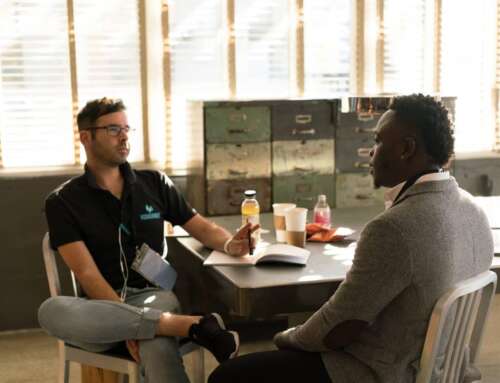As Certified Sex Coaches™ we are quite familiar with the integral role consent plays in creating pleasurable, safe, and healthy sexual experiences.
Consent is giving/getting permission or an agreement for something to happen. In the context of sex, it is typically referred to as an enthusiastic ‘YES’, obtained before, and throughout, any type of sexual activity.
Teaching consent as a sex coach is a core theme seen throughout our training at Sex Coach U, one we take very seriously as practitioners. We fully recognize that consent is about showing respect, mutuality (collaboration and cooperation within a relationship), giving, receiving, and interdependence. We become so adept at incorporating consent in how we relate to others, that it may not even register that we are doing it.
Part of supporting our clients to experience the sexual outcomes they desire involves helping them understand the importance of consent in their sexual relationships.
Consent can feel quite unsexy and almost businesslike for some, so helping our clients see the benefits of incorporating it into their sexual experiences is key. The great news is there are many ways we can, and do, teach consent to our clients.
Modeling Consent for Clients
Our main goal as a Sex Coach is to create a safe container in which our clients feel comfortable sharing some of the most vulnerable parts of themselves. In our initial encounters with our clients, we’re already laying the groundwork for what consent looks like in a relationship.
In discovery calls and initial coaching sessions, we establish a mutual agreement around what is and is not expected and permissible within the space of the time spent together. We inform clients about boundaries around our role as a coach, such as when we are and are not accessible to them, and how they may access us.
We get permission to gather information about their concerns, what topics may trigger them, and their sexual history. Consent is also obtained by having them sign a contract, giving us permission to provide our services and support to them.
Through our interactions during coaching sessions, emails, calls, etc. we model consent by maintaining boundaries and fostering mutuality. Mutuality within the coaching/client relationship is one of equality, respect, compassion, non-judgement, and empathy. Offering our clients the opportunity to experience this type of relationship with us provides a framework for them to seek these traits in their relationships with others.
PLISSIT: A Guide to Teaching Consent
Once coaching sessions have begun with clients, the PLISSIT (Permission, Limited Information, Specific Suggestions, Intensive Therapy/Coaching) model acts as an excellent guide for teaching consent.
We encounter clients in various stages of life and experiences, so it is important to understand what consent looks like for them. Knowing this information allows you to work with them to build on whatever foundation they currently have. Using PLISSIT to teach consent offers building blocks that will support your clients with the information and tools they need to feel confident about consent.
Permission
As common as consent is for us as professionals, many people are offered very little, if any, education about what consent should look like in the context of sexual experiences. We all can agree that there is a severe lack of appropriate sex education in most parts of the world.
Because of this, people often enter sexual experiences with little knowledge of what it means to truly give and receive consent. Giving our clients permission to use their enthusiastic yes offers them the opportunity to explore what that feels like for them. It has the potential to unlock sexual confidence they didn’t realize they had.
Limited Information
We can then offer limited information by clearly defining what consent is and how to incorporate it into a sexual experience. A great place to start is helping them understand that consent is the bare minimum for enjoyable sex.
Just obtaining a simple “Yes” is not a complete consent conversation. We need to help our clients understand that consent discussions should involve deeper discussions about what does/does not happen, what is desired, what is pleasurable, and that involves checking in throughout a sexual experience. A positive result of these conversations is that it opens the door for curiosity and can lead to more connection with a partner.
Alternative Models of Consent
Educating clients about different models of consent can significantly enhance their understanding and implementation of consent in sexual experiences. One such model is the FRIES model, developed by Planned Parenthood. FRIES stands for Freely-Given, Reversible, Informed, Enthusiastic, and Specific, offering a memorable framework for engaging in consensual sexual activities.
Other noteworthy models include CRISP, developed by Intimacy Directors & Coordinators, which stands for Considered, Reversible, Informed, Specific, and Participatory, and ECC (Engaged, Collaborative, and Co-Created). These models highlight the importance of ongoing consent and mutual participation in sexual decisions.
For instance, some clients may participate in sexual activities out of pressure or obligation rather than desire, leading to resentment, diminished sexual desire, and feelings of disempowerment. By introducing clients to these models of consent, we empower them to reclaim agency over their bodies and articulate their needs and boundaries clearly.
Teaching consent using these models can start with explaining the components of each acronym. To deepen understanding, we can facilitate practice dialogues where clients use these frameworks to express their preferences clearly—saying “Yes,” “No,” or articulating specific desires like “I want you to…”
This practice not only boosts their confidence but also reinforces their ability to navigate consent effectively in real situations.
Specific Suggestions
Many of our clients avoid having conversations about sex with a partner, especially ones including consent. This is why they come to see us! Fear of rejection, judgment, disrespect, and ridicule prevent them from opening up about sex with a partner.
There are many specific suggestions we can offer our clients to help them overcome these fears. I will outline a couple here.
One way is to encourage them to connect with their body to learn what their enthusiastic yes feels like and what their no feels like.
- This can be done by having them ask themselves “Do I want …?” questions.
- Have them start off with everyday things that they know they want or do not want. For example, if they like ice cream, have them ask themselves “Do I want ice cream?”
- Have them sit silently with that question and focus on the sensations in their body.
- On the flip side, if they hate liver, have them ask themselves “Do I want a liver sandwich?”
- Again, they should take time to focus on the sensations in their body.
- Once they have a decent gauge for what yes and no feel like, they can move on to questions involving sex.
It should be noted, however, that people pleasers may struggle with this exercise as they may autopilot and want to respond yes, even when they feel a no.
Another great specific suggestion comes from one of our required readings, Sexual Intelligence by Marty Klein. The hand massage exercise, found in Appendix 2, offers a way for clients to feel into the experience, notice what is happening, and then communicate with their partner, romantic or otherwise. It is a great way to practice communicating in a non-threatening, non-sexual space.
The 3 Minute Game outlined in Dr. Betty Martin’s book, The Art of Receiving and Giving: The Wheel of Consent offers a similar experience.
Intensive Coaching
During coaching sessions, we bring it all together by providing intensive coaching.
Coaching sessions provide a safe container to:
- practice communication skills
- explore what agency and autonomy mean to our clients
- learn what setting good boundaries looks like
- explain how consent may look and feel different in short-term vs long-term relationships.
Whether you are coaching couples or doing 1:1 sessions with a client, methods for intensive coaching around consent can be similar.
Communication skills can be practiced during sessions between you and your client, or between partners. This should include modeling communicating and listening, as consent goes both ways.
We can empower our clients through discussions about agency, independently making their own choices, autonomy, control over their own bodies, and boundary setting.
Finally, consent sometimes looks different for people in long-term relationships. It will be important to talk about what your client, or clients, want consent to look like in the context of where they are in their sexual journey.
Consent Empowers
When we teach our clients about consent, we are offering them the chance to explore their sexual power. Through this, they gain more confidence to speak up about who they are as sexual beings.
Being able to speak up about what they want, and don’t want, during a sexual experience frees them from experiences they don’t enjoy.
It results in heightened pleasure, improved communication skills, and a deeper sense of connection with one’s partner.
Teaching consent as a sex coach can be empowering and liberating. Consent can be quite sexy, and taking the time to teach our clients to talk about what they want sexually helps them experience the sex they want. I can’t think of a better outcome than that!
Curious about training to become a Certified Sex Coach™? We invite you to join our Sex Coaching in Action webinar to meet the Sex Coach U team and participate in a live Q&A.





